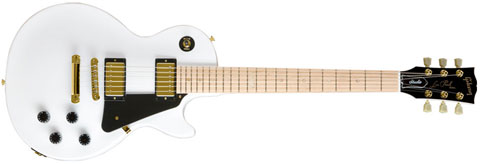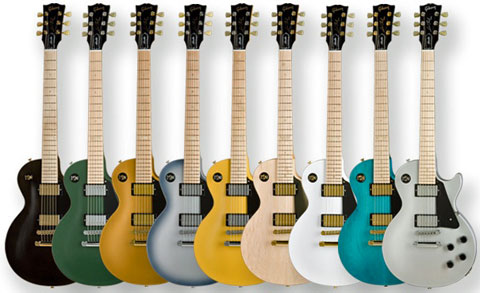Review: Raw Power Les Paul Sounds Good But…
Yesterday my son wanted to bang on the drums at Sam Ash and Guitar Center, which are across the street from one another here in northern New Jersey. So I sort of shrugged at my wife like, ‘Hey – I’m doing it for him,’ then ran for the car and took off!
(On the way there, my boy wanted to listen to Van Halen – he’s a good kid! – and I just kept saying to myself, “Don’t buy anything, don’t buy anything….”)
After listening to him bang on the drums for a while at Sam Ash, I made him take a break so I could check out the guitars (“don’t buy anything, don’t buy anything…”).
I wanted to play one of the Epiphone “korina” Vs because they look so dang cool, but instead pulled down a Gibson Raw Power Les Paul Studio. If you’re unfamiliar with these Raw Power guitars, they are all maple – yes, maple. If you’re unfamiliar with Les Paul construction, Les Pauls are supposed to be: mahogany body/maple top, mahogany neck, rosewood (usually) or ebony fingerboard.
[**Update: The original Raw Powers had solid maple bodies and a mahogany neck. The ones sold now are chambered maple with a maple neck.]
So an all-maple Les Paul? Gibson announced these guitars and Raw Power SGs on April 1, 2009. That being April Fools Day and the all-maple construction had half the world thinking that these guitars were a joke.
Turned out Gibson was serious.
Before getting into the review, here’s a quick overview of the specs. Anything not listed here means it’s the same as a Les Paul Standard, and the Raw Power SG specs are basically the same.
> Carved maple top “attached with ultra-strong Franklin Titebond 50 glue” to a chambered maple body.
> 3-piece maple neck, even though Gibson says it’s mahogany in at least one spot on its website.
> ’50s neck profile.
> Jumbo frets.
> Corian nut.
> 57 Classic pickups (Alnico II magnets).
> Hardware: Grover Kluson-style green-button tuners, Zamak (zinc alloy) tune-o-matic bridge and tailpiece.
I plugged it into a Marshall TSL combo – a surprisingly nice-sounding amp – using a dental-floss-thin cord that I assume Sam Ash hands out because they don’t care if people walk off with them. Still, it won’t allow the best properties of the guitar or amp come out. (Guitar Center clamps good cords to its amp racks.)
The Good
> VERY articulate, which you would expect with the maple. The notes really stand out: notes in chords blend together less.
> Surprisingly, the guitar had balls too – probably helped by the Marshall.
> 57 Classics sounded great in both positions.
> Light in weight for a Les Paul – not always a good thing tone-wise, but helps your back!
The Bad
> By far the worst thing is that this particular guitar, a white one, looked and felt like it was painted with either boat paint or exterior house paint. Not smooth, felt very thick. Literally the worst guitar finish I’ve ever seen or felt. It’s possible the one I played was a bad one since Gibson describes the finish this way: “A thin satin finish with 30-sheen lacquer gives the Les Paul Studio Raw Power a look that is clean and professional, but less glossy and polished than many traditional guitars, with a slightly raw, “pre-aged†appearance, and a smooth matt-finish feel.” Not my experience, but again, that was just one guitar.
> No binding because it’s a Studio. I just can’t get into Les Pauls without the binding.
> I didn’t like the dot fret markers with a trapezoid at the 12th fret. Looks like it was designed by committee. Pick one!
> Volume knobs/pots felt a little cheap, but maybe because it was a demo guitar.
The Neutral
> The neck seemed more like a thinner ’60s-type neck to me, but that might vary by guitar.
The Bottom Line
The Raw Power was the only Les Paul I played at the store because I “knew” what the other ones there would play and sound like. Plus, I’ve owned an all-maple guitar – an ESP-made George Lynch signature M-1 super strat (LTD version) – and it sounded really good. So I was curious about this maple Les Paul, Les Pauls being my favorite guitars.
I was a little surprised at the weight. I expected it to be heavier, though the aforementioned Lynch guitar wasn’t that heavy. I thought Gibson maybe found lighter “maple” – meaning a close relative of maple, which is all the rage these days in mass guitar-building. I have to confess I’m a little disappointed to learn the guitar was chambered – because the jury’s still out on the whole chambering thing for me.
The most important thing is that I really liked how it played and sounded, though it’s certainly not a classic Les Paul sound. I love the articulation of the maple because I crave that piano-like note separation.
Even though – or maybe because – the Raw Power Les Paul doesn’t sound like a “regular” Les Paul, I might seriously consider buying one…but only if they were fire-sold at around $400 – greater than 50% off the Sam Ash in-store price of $899. Then I’d have to refinish it, and maybe take a look at replacing those knobs and pots.
In case you want one of these things, I’ll repeat my oft-stated advice: Even if you have bad GAS, do NOT buy a guitar without playing it first! Or at least have the option of returning it if you don’t like it.
Notable
> For the full Raw Power specs, click here to go to the Gibson website. I checked out the sound clips there, but they really don’t do the guitar justice. All the links to the Raw Power SG spec pages are broken, but assume roughly the same specs for the SG.
> Gibson takes a lot of heat for some of its newer designs – some of which are definitely odd, which is being charitable. The following post was at the top of the comments on the Raw Power announcement, and it cracked me up. Hope you enjoy, from ‘Grimlok’ (user name): “This is a prelude to the Gibson Les Paul Hobo. It’s made from tomato crates with a carved balsa top. Whoever is dreaming up this stuff at Gibson, fire them.”
_____
As for the “don’t buy anything, don’t buy anything” mantra, well…I bought something. More on that in a future post.















